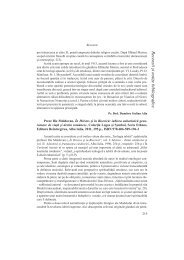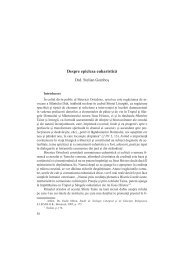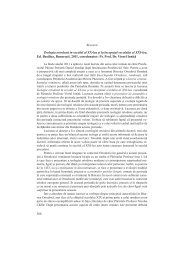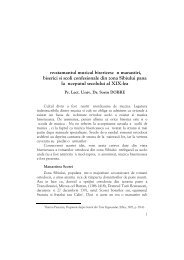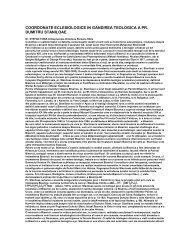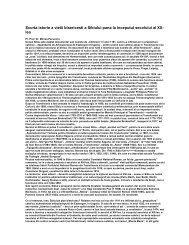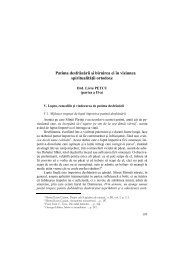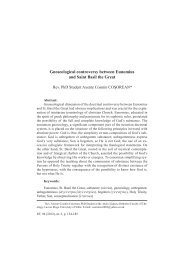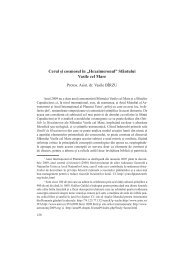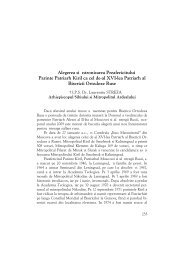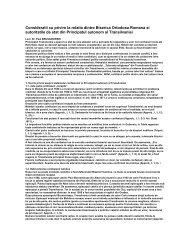Elemente de filantropie şi asisten ă socială în ... - Revista Teologica
Elemente de filantropie şi asisten ă socială în ... - Revista Teologica
Elemente de filantropie şi asisten ă socială în ... - Revista Teologica
Create successful ePaper yourself
Turn your PDF publications into a flip-book with our unique Google optimized e-Paper software.
STUDII ŞI ARTICOLE<br />
alimentate <strong>de</strong> donaţii testamentare. Sistemul a fost sl<strong>ă</strong>bit <strong>de</strong> vânzarea bunurilor<br />
instituţiilor caritabile, dar <strong>în</strong>cetul cu <strong>în</strong>cetul, spitalele î<strong>şi</strong> reg<strong>ă</strong>sesc propriet<strong>ă</strong>ţile <strong>şi</strong><br />
rentele. Acest mijloc <strong>de</strong> finanţare r<strong>ă</strong>mâne totu<strong>şi</strong> precar faţ<strong>ă</strong> <strong>de</strong> nevoile instituţiei<br />
spitaliceşti, cu atât mai mult cu cât randamentul economic al patrimoniului spitalelor<br />
este foarte mo<strong>de</strong>st.<br />
Pivotul sistemului <strong>de</strong> <strong>asisten</strong>ţ<strong>ă</strong> social<strong>ă</strong> r<strong>ă</strong>mâne „spitalul general”. O evoluţie<br />
lent<strong>ă</strong> tin<strong>de</strong> s<strong>ă</strong> opun<strong>ă</strong> spitalul, ospiciului, dar numai <strong>în</strong> comunele cele mai importante<br />
<strong>şi</strong> mai bogate. Spitalul se medicalizeaz<strong>ă</strong>, se elaboreaz<strong>ă</strong> o nou<strong>ă</strong> ştiinţ<strong>ă</strong> terapeutic<strong>ă</strong>.<br />
Ospiciul p<strong>ă</strong>streaz<strong>ă</strong> o dimensiune penal<strong>ă</strong> moştenit<strong>ă</strong> <strong>de</strong> la politica <strong>de</strong> <strong>în</strong>carcerare din<br />
epoca clasic<strong>ă</strong>. Spitalul r<strong>ă</strong>mâne sursa esenţial<strong>ă</strong> <strong>de</strong> <strong>asisten</strong>ţ<strong>ă</strong>. În 1840, când spitalele<br />
cheltuiesc anual pentru ajutoarele publice 49 <strong>de</strong> milioane <strong>de</strong> franci, birourile <strong>de</strong><br />
binefacere nu cheltuie <strong>de</strong>cât 9. În zorii anului 1848, <strong>în</strong> Franţa, exist<strong>ă</strong> 1338 <strong>de</strong> spitale<br />
<strong>şi</strong> ospicii cu venituri foarte inegale. 5% din spitale posed<strong>ă</strong> trei sferturi din resurse.<br />
Regiunile cele mai bine dotate sunt cele mai puternice din punct <strong>de</strong> ve<strong>de</strong>re economic<br />
<strong>şi</strong> cele a c<strong>ă</strong>ror <strong>în</strong>cadrare religioas<strong>ă</strong> este cea mai pronunţat<strong>ă</strong>. Spitalul este <strong>în</strong>ainte <strong>de</strong><br />
toate o instituţie urban<strong>ă</strong> <strong>şi</strong> apoi parizian<strong>ă</strong>. Între 1800 <strong>şi</strong> 1850, au fost create nu mai<br />
puţin <strong>de</strong> treizeci <strong>de</strong> spitale. Filantropii foarte critici faţ<strong>ă</strong> <strong>de</strong> cheltuielile <strong>de</strong> spitalizare<br />
<strong>în</strong><strong>de</strong>amn<strong>ă</strong> la externalizare 18 . Birourile <strong>de</strong> binefacere, create <strong>în</strong> 1796 cu scopul <strong>de</strong> a<br />
organiza la domiciliu <strong>asisten</strong>ţa s<strong>ă</strong>racilor, au fost alipite administraţiei municipale.<br />
Ele g<strong>ă</strong>sesc resurse <strong>în</strong>tr-o tax<strong>ă</strong> pe spectacole, <strong>în</strong> donaţiile particularilor <strong>şi</strong> <strong>în</strong><br />
subvenţiile municipalit<strong>ă</strong>ţilor. Parisul posed<strong>ă</strong> un birou pentru fiecare arondisment.<br />
Aceste birouri distribuie pâine, sup<strong>ă</strong>, lenjerie, uneori mobil<strong>ă</strong>, cearşafuri. Câţiva<br />
medici dau consultaţii <strong>şi</strong> efectueaz<strong>ă</strong> vaccin<strong>ă</strong>ri gratuite. Progresiv, birourile <strong>de</strong><br />
binefacere au <strong>de</strong>venit pivotul muncitoresc al unei <strong>asisten</strong>ţe foarte variate acordate<br />
s<strong>ă</strong>racilor. Aceasta merge <strong>de</strong> la plasarea copiilor ucenici pân<strong>ă</strong> la <strong>în</strong>humarea gratuit<strong>ă</strong>,<br />
trecând prin distribuirea picioarelor <strong>de</strong> lemn sau reducerea dreptului <strong>de</strong> patent<strong>ă</strong>. O<br />
reţea complex<strong>ă</strong> <strong>de</strong> instituţii vechi <strong>şi</strong> mo<strong>de</strong>rne, religioase <strong>şi</strong> laice, <strong>în</strong>cearc<strong>ă</strong> s<strong>ă</strong> ajute, s<strong>ă</strong><br />
st<strong>ă</strong>vileasc<strong>ă</strong>, s<strong>ă</strong> controleze <strong>şi</strong> s<strong>ă</strong> moralizeze societatea s<strong>ă</strong>racilor. Societatea<br />
filantropic<strong>ă</strong>, lansat<strong>ă</strong> <strong>de</strong> B. Delessert <strong>în</strong> 1800, <strong>în</strong>cearc<strong>ă</strong> s<strong>ă</strong>-i ajute pe nevoia<strong>şi</strong> <strong>şi</strong> î<strong>şi</strong><br />
fixeaz<strong>ă</strong> ca obiectiv s<strong>ă</strong> aduc<strong>ă</strong> ajutoare temporare muncitorilor graţie dispensarelor <strong>şi</strong><br />
cantinelor sale. Ea vrea s<strong>ă</strong> le inculce <strong>şi</strong> simţul economiei. Numeroase societ<strong>ă</strong>ţi<br />
fondate <strong>de</strong> donatori „genero<strong>şi</strong>” pun <strong>în</strong> aplicare <strong>în</strong> 1840 dispensare sau mici ospicii<br />
care ofer<strong>ă</strong> ajutor medical gratuit, distribuie lenjerie, sup<strong>ă</strong>, pâine. Cer<strong>şi</strong>tul este<br />
reprimat <strong>în</strong> continuare: <strong>în</strong>chisorile pentru cerşetorie <strong>şi</strong> casele <strong>de</strong> refugiu îi trateaz<strong>ă</strong><br />
<strong>în</strong>c<strong>ă</strong> pe s<strong>ă</strong>raci prin <strong>în</strong>carcerare.<br />
„Turnurile” bisericilor, dispozitiv principal care primeşte sub anonimat copiii<br />
abandonaţi, sunt suprimate treptat. Primele creşe sunt create <strong>de</strong> F. Marbeau <strong>în</strong> 1844,<br />
s<strong>ă</strong>lile <strong>de</strong> azil primesc copiii nevoia<strong>şi</strong> pân<strong>ă</strong> la 6 ani. Atelierelor <strong>de</strong> lucru municipale li<br />
se adaug<strong>ă</strong> cele care erau conduse <strong>de</strong> c<strong>ă</strong>lug<strong>ă</strong>ri, filantropii interesându-se <strong>de</strong> coloniile<br />
agricole pentru tinerii nevoia<strong>şi</strong> inspirate <strong>de</strong> exemplele olan<strong>de</strong>ze <strong>şi</strong> belgiene. În 1818,<br />
510<br />
18 Ibi<strong>de</strong>m, p. 23.



